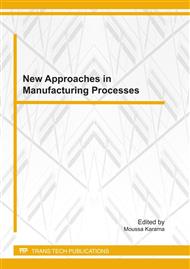[1]
Aydemir, A et al. An adaptive simulation approach designed for tube hydroforming processes. Journal of Materials Processing Technology, May 2004, vol. 159, pp.303-310.
DOI: 10.1016/j.jmatprotec.2004.05.018
Google Scholar
[2]
Jansson, M, et al, On process parameter estimation for the tube hydroforming process. Journal of Materials Processing Technology, 2007, vol. 190, pp.1-11.
DOI: 10.1016/j.jmatprotec.2007.02.050
Google Scholar
[3]
Fann, K-J, Hsiao, P-Y, Optimization of loading conditions for tube hydroforming. Journal of Materials Processing Technology, 2003, vol. 140, pp.520-524.
DOI: 10.1016/s0924-0136(03)00778-7
Google Scholar
[4]
Imaninejad, M et al. Loading path optimization of tube hydroforming process. International Journal of Machine Tools & Manufacture, March 2005, vol. 45, pp.1504-1515.
DOI: 10.1016/j.ijmachtools.2005.01.029
Google Scholar
[5]
Abderrabbo, N, et al. Wrinkling control in aluminum sheet hydroforming. International Journal of Mechanical Sciences, 2005, Vol. 47, p.333–358.
DOI: 10.1016/j.ijmecsci.2005.02.003
Google Scholar
[6]
Cherouat, A. et al. Numerical improvement of thin tubes hydroforming with respect to ductile damage. International Journal of Mechanical Sciences, 2002, Vol. 44, pp.2427-2446.
DOI: 10.1016/s0020-7403(02)00177-7
Google Scholar
[7]
Gantar, G, Kuzman, k, Optimization of stamping processes aiming at maximal process stability. Journal of Materials Processing Technology, 2005, vol. 167, pp.237-243.
DOI: 10.1016/j.jmatprotec.2005.05.027
Google Scholar
[8]
Karthk, V., et al. Variability of sheet formability and formability testing. Journal of Materials Processing Technology, 2002, Vol. 121, p.350–362.
DOI: 10.1016/s0924-0136(01)01219-5
Google Scholar
[9]
Zhang, W, Shivpuri, R. Probabilistic design of aluminum sheet drawing for reduced risk of wrinkling and fracture. Reliability Engineering and System Safety, March 2008, vol. 94, pp.152-161.
DOI: 10.1016/j.ress.2008.02.024
Google Scholar
[10]
Youn, Byeng D, et al. A new response surface methodology for reliability-based design optimization. Computers and structures, September 2003, vol. 82, pp.241-256.
DOI: 10.1016/j.compstruc.2003.09.002
Google Scholar
[11]
Enevoldsen I, Sorensen JD. Reliability-based optimization in structural engineering. Struct Safety 1994; 15: 169–96.
Google Scholar
[12]
Youn, B, D, Choi, K, K. Selecting probabilistic approaches for reliability-based design optimization. AIAA Journal. 2008, 42, p.124–131.
DOI: 10.2514/1.9036
Google Scholar
[13]
Bing, Li, et al. Reliability analysis of the tube hydroforming process based on forming limit diagram. Journal of pressure vessel technology, 2006, Vol. 128, p.402–407.
DOI: 10.1115/1.2218344
Google Scholar
[14]
Kleiber, M et al. Response surface method for probabilistic assessment of metal forming failures. International journal for numerical methods in engineering, 2004, Vol. 60, pp.51-67.
DOI: 10.1002/nme.954
Google Scholar
[15]
Bing, L et al. Improving the Reliability of the Tube-Hydroforming Process by the Taguchi Method. Journal of Pressure Vessel Technology, May 2007, vol. 129, pp.242-247.
DOI: 10.1115/1.2716427
Google Scholar
[16]
Kleiber, M et al. Reliability assessment for sheet metal forming operations. Computer Methods in Applied Mechanics and Engineering, August 2002, Vol. 191, pp.4511-4532.
DOI: 10.1016/s0045-7825(02)00394-8
Google Scholar
[17]
Koç, M et al. Prediction of forming limits and parameter in the tube hydroforming process. International Journal of Machine Tools and Manufacture, 2002, vol. 42, pages 123-138.
DOI: 10.1016/s0890-6955(01)00048-7
Google Scholar
[18]
Donglai, W, et al, Optimization and tolerance prediction of sheet metal forming process using response surface model. Computational materials science, 2008, vol. 42, pp.228-233.
DOI: 10.1016/j.commatsci.2007.07.014
Google Scholar
[19]
Jansson, T et al. Reliability analysis of a sheet metal forming process using Monte-Carlo analysis and metamodels. Journal of materials processing technology, 2007, vol. 202, pp.255-268.
DOI: 10.1016/j.jmatprotec.2007.09.005
Google Scholar
[20]
Myers, R, H, Montgomery, D, C. Response surface methodology: process and product optimization using designed experiments. 2nd ed. USA. John Wiley and sons. ISBN 0-471-41255-4.
Google Scholar
[21]
ABAQUS Inc., ABAQUS/Explicit User's Manual, Version 6. 5, (2005).
Google Scholar
[22]
The Mathworks. Manuel de référence du logiciel Matlab, (2007).
Google Scholar


